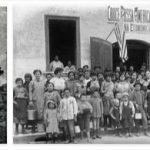Among the linguistic forces which, once the cavalry has faded, establish a new, unitary German against the use of literary dialects, more in keeping with the changed times, the action of Chancellorish German was much more powerful than the grammars (based on Italian models). Having passed the court in Vienna with Albert II, especially thanks to Maximilian I, assisted by the chancellor Anselmo Ziegler, the German chancellor, instead of accentuating the High-German characteristics, abstracts from too specific Bavarian dialectal traits. The chancelleries of central Germany are governed by the example of Vienna. In the mid-fifteenth century, the Thuringian-Saxon one accepted the diphthongs introduced by the chancellery of theu, and for ei: Kleed – Kleid, and ai for eu: Laide – Leute) still in use in Meissen. Literary High German was transported in 1480 by Albert of Meissen to Mainz. This linguistic type also conquered Lower German areas: the Chancellery of Halle made use of it during the course of the century. XV, that of Berlin introduces it in 1504.
While this linguistic unification has little resonance in spoken German, the arts guilds, extensive and branched throughout Germany, enrich the lexicon with valuable elements. Dozens of words entered the national lexicon from the miners’ jargon (Ausbeute, Fundgrube, Schicht, reichhaltig, etc.); from that of the soldiers it is enough to recall, among the many, Lärm, Ausflucht, Gelegenheit ; from the forensic language passed into the modern lexicon, together with several Latinisms, not only happy translations (manu tener: ” handhaben “), but also lexical creations that became popular over time (aufschieben, entschuldigen,überzeugen). The press that penetrates schools and homes also acts in a unifying sense: the large publishers accept the grammatical codification of German and the normalization of spelling. Thus, even before Luther, the conditions for the linguistic unification of Germany existed. But what neither the poets, nor the scientists, nor the chancelleries had been able to achieve, because they lacked the support of the popular masses, is achieved by the Reformer. Through a severe self-critical work of selection, avoiding the stylistic and lexical elements of the language of the learned and of the chancelleries that seemed incompatible with a popular language, choosing clear, precise and popular words, expressions, syntactic and stylistic constructions, basing himself on the phonetic aspect and spelling on the German chancellor of the Saxon court, which in essential points combined with the imperial one, he was able to give in the translation of the Bible a German that proved to be suitable for the mentality of his people. In his choice of voice, Luther did not shy away from dialectal expressions (Scheune, Lippe, bange, etc.) neither from the creation of new phrases and voices, nor from semantic changes of popular terms, used in translation to indicate philosophical concepts (Grund passed from “bottom” to “cause”). The Reformation spreads Luther’s German throughout Protestant Germany; it also profoundly influences the Catholic translations of the Bible, and once the religious troubles have ceased, the slight dialectal differences that the Bavarian writers of the 16th-17th centuries artificially maintained in opposition to the “Lutheran” use disappear. “grammarians recognize Luther’s Bible as a text (Clajus, Germanic Grammar, 1578). For the triumph of Luther’s German it will suffice to remember that the chancellery of Mecklenburg adopted it in 1548 and that the last Low-German translation of the Bible dates back to 1621.
The new linguistic type was sustained in extremely difficult times. Following the example of Charles V, the courts, and not only these, are adapted to the enslavement of fashion and the French language. As early as 1571, a 250-page German dictionary of foreign words was printed. French language teachers are scattered everywhere; the Huguenots, expelled from France, hardly forget their language; during the Thirty Years War, French fashion spread to the popular classes; the young M. Opitz protests against the neglect of the national language (Aristarchus sive de contemptu linguae germanicae, 1617). The literary reaction manifests itself in the same year with the foundation of the Fruchtbringende Gesellschaft, due to Lodovico of Anhalt-Köthen, of which 800 “cruscanti” belonged. Two of them, JG Schottel and Ch. Gueinze, published two German grammars in the same year (1671) (the second is largely the German grammatical terminology). The defects of this and other similar societies are those of the time; the great merit lies in having reinvigorated the national spirit and enunciated the need to react to linguistic barbarism. Ph. V. Zesen (1619-89), fanatic but slandered opponent of foreign voices, if he created terms that died in ridicule, substituted dozens of words for as many non-German voices (for example,Vertrag for Kontrakt, Ausübung for Praxis). However, the effort of these circles was not enough to put an end to the evil that had too many and too deep roots and which increased up to Frederick II of Prussia.
The stylistic trends of the century. XVII and the first half of the following, especially the Baroque, had no beneficial influence on the language; some lexical creative force should be recognized in pietism. The Enlightenment, with Chr. Wolff, brings a new philosophical terminology (eg. Aufmerksamkeit, Bedeutung, Verständnis), while his grammatical theories (the preconception of rationally demonstrating the rules of linguistic use: J. Chr. Gottsched) prove to be ephemeral. But Gottsched’s attempt to ennoble the literary language on a puristic basis, with a clear, precise, straight style, if it was fought by the Swiss school in the name of fantasy and sentiment, in practice triumphs, as Bodmer, Breitinger and Haller refine the their expression and, without denying the plastic force of their dialect, they adhere to the literary German of Germany. The fusion of the two theories is achieved not with Klopstock, in whose Messiahthe passionate element predominates over the conventionality and rigidity sought by Gottsched (the linguistic importance of Klopstock lies in the enrichment of the lexicon with many neologisms, such as beflügeln, aufflamen, zahllos); not with the poets of the “Sturm und Drang” who continue the tendencies of the Swiss school and have the merit, before the romantics, of having given birth to several Old-German terms (Mmne, Gau, Märe, Recke, anheben, etc.) and to have drawn extensively from lexical sources; but with Lessing. He replaces the pathetic style with a clear, strong and lively diction; he does not hesitate to prefer a German that has resonance in the dialectal substrate to an abstract language; without exceeding purism, substitutes new indigenous voices for foreign words (e.g., gleichförmig instead of konsequent, Vernunftlehre for Logik, Schaubühne for Theater). If the tendency towards the antithesis and the epigrammatic point, which we also find in Schiller, are reflections of French culture, his solid and simple style, which also involves a rhythmic movement in prose and in which the study of expressive truth and clarity is evident, it is absolutely national.
Goethe and Schiller have their roots in the “Sturm und Drang” of which they maintain the expressive power, vivacity and boldness. In the works of maturity are added the care of the musicality of the word, of the syntactic symmetry, of the stylistic proportion, the ability to adapt the expression to the affective degree. It is enough to read the re-editions of Schiller to grasp a vigilant puristic sense (eg, in the “walk” of the Horen, ein mystischer Pfad becomes ein schlängelnder Pfad). In Goethe, style is in constant flux. In his early works the attempts to overcome the current poetic language at all costs are daring; lexical creations (schellenlaut, Tatensturm) and the biblical color (Luther’s influence) give a personal imprint. Francesisms of the first way are soon overtaken; less easily, even in rhyme, the poet frees himself from dialectal forms. In Weimar, with Egmont and Iphigenie stylistic perfection is achieved. The clarity of the syntactic construction even in the most impetuous creations suggested to P. Leroux the well-known comparison with Voltaire. It is surprising how the simplest linguistic means suffice for this ruler of expression. Later the bureaucratic style (Geheimratstil) stiffens that of the poet.
The tendency to purism, already strengthened by the vigorous literary tradition, widened with the Francophobia, after 1806. Never as in this period did the German try to redeem himself from Frenchisms (for example, Esslust replaces Appetit, Umlauf – Zirkulation, etc.) ; the exponent of this movement is J. Campe, author of the Wörterbuch der deutschen Sprache(1807). The profound difference between the classical ideal and the romantic one could not fail to manifest itself in the style. The syntactic and stylistic equilibrium of the former is replaced by the pressing of short propositions that do not resolve the stylistic tension; the principle of euphony is pushed to its ultimate consequences and is placed in charge of expressive clarity and the concept itself; linguistic correctness takes precedence over the writer’s creative freedom; the anomaly is preferred to traditional use. Love for the Middle Ages makes us look for archaisms; the German’s admirable ability to create new compounds is widely exploited (Waldeinsamkeit, geisterhaft, riesig). Largely in opposition to the romantic theory, but under its influence, the Grimm brothers inaugurated with the Deutsche Grammatik and with the Deutsches Wörterbuch historical-comparative grammar and historical-etymological lexicology.
During the twentieth century, to a much greater extent than in previous centuries, schools, theater and newspapers contributed to bringing written German closer to the popular language for which the gap between written and spoken language decreased following a rapid development of the latter, which tends to supplant the dialect.
Dialects
According to top-medical-schools.org, the dialects are divided into the two large families of Low-German and Middle and High-German. The Lower Franconian, Lower Saxon and Lower East German groups belong to the former; to the second the three groups from Central Germany (Middle-German; Middle-West Franconian, Thuringian and East-Middle Franconian) and the three from Southern Germany (High German: Upper Franconian, Alemannic and Bavarian). Each of them is divided into subgroups; so p. ex. to the purest Low Franconian which, according to the treatment of î û, is distinguished in salic (ei, eu) and ripuario (i, u in schriven “to write”, hus”home”), two areas are added in which the dialectal type is altered by other elements – Franconian Frisian, spoken in West Flanders, Zeeland, Holland, Veluwe, Utrecht Province and Saxon Franconian, extended to part of the Netherlands and, in Germany, along the right bank of the lower Rhine and the Ruhr to Essen -. Even the Bavarian group (to which the dialects of Atesini and the Trentino-Veneto oases belong) is divided into very distinct subgroups: thus, Fr. ex. Northern Bavarian approaches the Middle German type in the treatment of Germanic ê, ô which are carried not to íe úo, but to éi, óu (léip for lieb,góut per gut) and of ê, ô aat carried out in äi, ou (Kläi for Klee, grouss for gross), while the bav. central and southern Austrian dialects say líab, güot and khlee, gross and, more in S., khlea, groass. In the Eastern Alps, the Tyrolean and the Tyrolean have maintained or assumed some particularities of the neighboring Alemannic which the Carinthian and Styrian lacks, characterized instead by peculiar phonemes and neo-hyphemes. The dwindling dialects of the oases offer types particularly notable for archaism.









